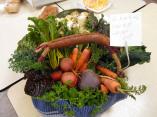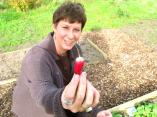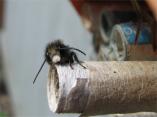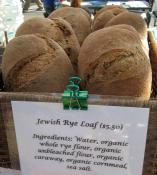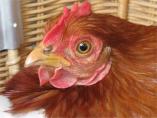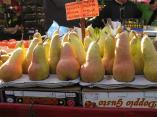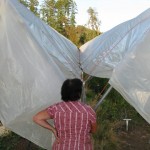The COG-VI tour this month was to 30-acre Kildara Farms, organic since 1994 and run by Brian and Daphne Hughes. They started off with an apple orchard; went into strawberries but tired of feeding the deer, and are now supplying year round organic greens to local supermarkets.
They rinse the greens, then wash them in food grade hydrogen peroxide solution (1:1000) and then rinse again and spin them dry (equipment and surfaces are sterilized with 1:25 solution). When asked why they use this rather than bleach, which many organic suppliers in the US use, Brian replied, “One word: chlorine.” He says there’s always chlorine residue regardless of rinsing. For two years they have used a strict testing protocol, to avoid any issues with food-borne illnesses. As many travellers have found, salad greens, because they are eaten raw, are particularly vulnerable to these – if birds or other wildlife come into contact with them while growing in the fields or in open greenhouses. So Brian has the greens tested twice weekly for peace of mind, and provides test results to the retailers as well.
We looked at two different sets of greenhouses. The first were designed by British farmers whose company – Haygrove – quickly cornered the polytunnel market. They’re immense structures which can be extended to cover acres of ground, and use y-shaped posts that allow them to be extended efficiently in rows. They’re also simple to construct and inexpensive (by greenhouse standards) to erect, using legs which can be screwed into the ground and hold fast to clay soil. You can add deer fencing around the perimeter, which is open for better ventilation. Because the plastic is lashed in place by ropes rather than clipped, it is simpler and quicker to put up and take down. Any greenhouse is vulnerable to bad weather and these are no exceptions: during one particularly bad storm the plastic came loose twice in the same day. But they are otherwise working very well and are easy to ventilate further in hot weather, by just lifting and clipping the plastic as needed.
Next we looked into some Harnois greenhouses, made in Quebec. Fancier and more expensive, and full of winter greens – in this case Mizuna – which can grow unheated, or be covered by row cover if it get very cold. The watering system mists from overhead: more efficient than watering tapes, according to Brian, but in need of constant checking as the heads get clogged very easily.
The greehouse sides are enclosed so need to be ventilated during hot and sunny days. Pickers were at work while we were there, taking advantage of the evening cool (the greens start wilting by about 11 am). They chill the greens overnight before washing, sorting, weighing and bagging them. Kildara uses biodegradable bags – they used to use plastic clamshells but discovered that people were failing to recycle these and sending them to the landfill, so opted to change to bags for environmental reasons.
Kildara is one of a number of farms and food places on the North Saanich Flavour Trail this weekend.
